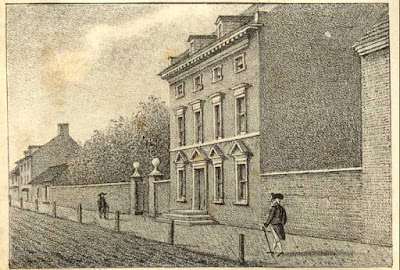HISTORY
The first European settlers in Pennsylvania were from Sweden. They arrived in 1643 and part of the present state (along the Delaware River), together with the present State of Delaware was organized as the Colony of New Sweden.
On March 4, 1681, Charles II of England, gave a large area of land between Maryland and present-day western New York to William Penn. His father, Admiral Penn had been a loyal supporter of the king. Penn used the land to create a home for Quakers.
 |
| Penn's Treaty with the Indians, by Edward Hicks |
Penn drafted a charter of liberties for the settlement creating a political utopia guaranteeing free and fair trial by jury, freedom of religion, freedom from unjust imprisonment and free elections that became a model for modern democracies around the world.
The land became known as "Penn's Woods", as Pennsylvania has many forests. In Latin this is "Pennsylvania". This became adopted as the name of the colony.
The explanation for the phrase "raining cats and dogs," meaning a heavy downpour is thought to date back to German migrants who had settled in south-eastern Pennsylvania. Their English was hard to understand. Heavy showers reminded them of a popular saying "back home." It spoke of raining so much that it kept in the cats and brought out the ducks. In their strong German accent the ducks sounded very much like dogs. Those listening to them, puzzled by what they were talking about, misunderstood them to say that it was raining cats and dogs. The strange combination of two pets that usually keep strictly apart, made the bizarre phrase all the more memorable.
Armies from France and Great Britain fought for control of the source of the Ohio River in the western part of Pennsylvania during the mid-18th century as part of the French and Indian War. Great Britain eventually won the conflict for this location and built a fort called Fort Pitt. The fort grew into a city which is now called Pittsburgh.
Benjamin Franklin was elected to the Pennsylvania Assembly in 1750, serving there until 1764. He transformed Philadelphia by giving it a police force, paving and lighting the streets and improving the fire brigade.
The first solely medical hospital in North America, the Pennsylvania General Hospital was established in Philadelphia in 1751.
The Pennsylvania Packet & General Advertiser, launched in 1784, was the first successful regular daily newspaper in the United States.
Pennsylvania was one of the 13 colonies that fought Great Britain in the American Revolution. Valley Forge near Philadelphia was General Washington's headquarters during the bitter winter of 1777–78.
After the war, Pennsylvania was the second state to join the United States and Philadelphia was capital of the United States before Washington, D.C..
The Masters-Penn mansion housed Pennsylvania's governor in the early 1770s. It later served as the presidential mansion of George Washington and John Adams, 1790–1800, while Philadelphia was the temporary national capital.
 |
| President's House (Masters-Penn Msnsion). |
Pennsylvania is misspelled "Pensylvania" on the Liberty Bell, because that is how they spelled it in the 18th century.
The Whiskey Rebellion broke out August 1, 1794 in Western Pennsylvania. Farmers revolted in protest to an excise duty on stills and spirits distilled in the U.S. George Washington later ordered in the militia and managed to end the rebellion without bloodshed.
 |
| The Whiskey Rebellion |
Kerosene was discovered in Titusville, Pennsylvania in 1859, leading to the start of the oil industry in the United States.
The Battle of Gettysburg was fought July 1–3, 1863 in and around the town of Gettysburg, Pennsylvania.
Large deposits of coal were found in and around Pittsburgh in the 19th century. This caused Pittsburgh to become a major industrial city.
Charles Hires, the first person to successfully market a commercial brand of root beer, decided to call his drink "root beer" despite it not containing any alcohol because he wanted to market it to Pennsylvania coal miners.
Built by the old Pennsylvania Railroad, the Rockville Bridge in Harrisburg opened on March 30, 1902. It is the longest stone masonry arch railroad viaduct in the world. The bridge is considered an icon of railroad engineering—it is 3,820 feet long, composed of 220,000 tons of stone, and took 800 laborers two years to build.
 |
| Rockbille Bridge By Don Kasak from St. Louis, MO, US - Wikipedia |
FUN PENNSYLVANIA FACTS
Pennsylvania's highest point happens to be lower than the lowest point in Colorado.
Pennsylvania has 140 miles (225 km) of shoreline along Lake Erie and the Delaware Estuary.
The University of Pennsylvania has produced 25 billionaires, the most of any college in the world.
 |
| The University of Pennsylvania quadrangle in Philadelphia |
Leally speaking, there is only a single town in Pennsylvania; Bloomsburg. Every other municipality is either a city, township, or borough.
Pittsburgh has been rated two times as the “Most Livable City” by Places Rated Almanac. The city was honored with the title first in 1985 and most recently in 2007.
Mushrooms are one of the most important crops for the state; ranking second in economic importance after greenhouse and nursery products. Happy Kennett Square, Pennsylvania is considered the mushroom capital of the world and harvests one million lbs of mushrooms each year.
The King of Prussia Mall in Pennsylvania, the biggest in the US is located in King of Prussia, a census-designated place within Upper Merion Township, Montgomery County in southeastern Pennsylvania, just outside Philadelphia.
 |
| Entrance to King of Prussia Mall By Dough4872 - Wikipedia |
Hershey, Pennsylvania is one of the most popular tourist attractions in the state. Chocolate Avenue in downtown Hershey is filled with street lamps (Kiss Lamps) in the shapes of the renowned treats.
Pennsylvania's state parks all have free admission, which means you can go out and enjoy the outdoors without spending one cent.
Sources Europress Enyclopedia, Geneva.edu/blog
No comments:
Post a Comment